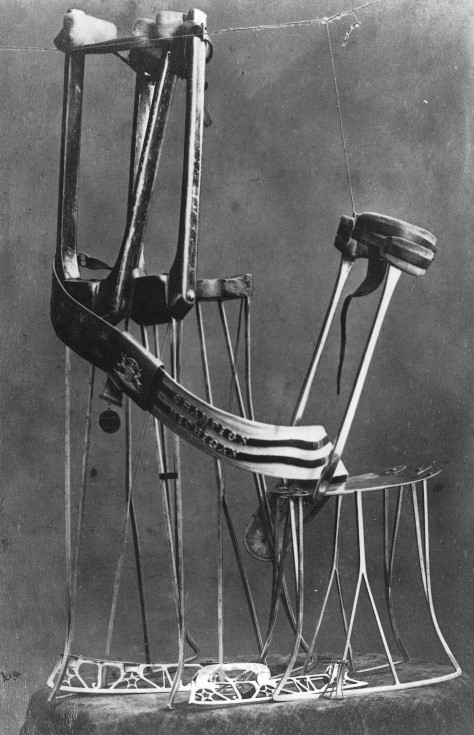Photo courtesy Musée McCord Museum. Reproduced for educational purposes under license permission.
He was an esteemed captain and builder of ships for fifty years, never losing a single ship or a man in his employ while at sea. A March 2014 article from the Detroit Historical Society noted that "Miner's reputation as a true gentleman has been well noted throughout the historic record. A man of fair business dealings in every sense, he was known for his infrequent use of alcohol, tobacco, and other social vices." No Caribbean rum for this straight edged captain, apparently. I won't hold it against him. The final ship he designed and built was called a passenger propeller called the Skater, undoubtedly named after this captain's passion for (you guessed it) figure skating.
Left: Captain John Miner in action. Right: A pair of Captain John Miner's stilt skates, which are in the possession of the Detroit Historical Society
The Detroit Historical Society's article gives some wonderful insight into the good captain's passion for skating: "While building and sailing ships was a lucrative occupation for Miner, his true passion in life rested in the winter recreational sport of ice skating. Miner was known to spend as much time as possible on the ice as soon as the winter cold froze area ponds and lakes. He was apparently quite a marvel at speed, acrobatics, and agility. Miner submitted a patent in 1897 for an innovative skate runner designed to greatly increase speed. Having won numerous prizes and medals, his biggest self-accomplishment was a solo performance before England's Queen Victoria. One of Miner's more fanciful and entertaining feats was the use of his 'stilt-skates' which elevated him an astonishing two feet off the ice while performing unbelievable manoeuvres." Miner's 'racing blade' design (more suitable for speed than figure skating) was officially patented on Valentine's Day, 1899.
Close-up of a pair of Captain John Miner's stilt skates. Photo courtesy Musée McCord Museum. Reproduced for educational purposes under license permission.
An article from the book "History on Ice and Roller Skating - 1916" published by Julian T. Fitzgerald, offers some further explanation of the captain's skating career: "This great skater was the father of stilt skating, having made and used the first pair of stilt skates in America. He won the speed and figure skating championships of Michigan 1861, he competed in the first National figure skating Championship at Pittsburgh, Pa. 1871, against (E.T.) Goodrich, (Callie) Curtis and (Johnnie) Engler." At some point along the way, the captain also developed a taste for roller skating, as it would have of course been much more common back in those days for skaters to learn to perform proficiently both on rollers and ice skates. Even within the last month of his life at seventy eight years of age, he was still roller skating regularly at Wayne Rink in Detroit. An honorary Protopopov or Richard Dwyer if there ever was one! Captain John Miner passed away on July 10, 1909 of an asthmatic/bronchial condition and is buried in Detroit's Mount Elliott Cemetery. Whether you're out on a ferry or a yacht, the next time you find yourself out at sea, raise a glass to the good skating captain... but since he didn't drink, if he asks it's just soda.
Skate Guard is a blog dedicated to preserving the rich, colourful and fascinating history of figure skating. Over ten years, the blog has featured over a thousand free articles covering all aspects of the sport's history, as well as four compelling in-depth features. To read the latest articles, follow the blog on Facebook, Twitter, Pinterest and YouTube. If you enjoy Skate Guard, please show your support for this archive by ordering a copy of the figure skating reference books "The Almanac of Canadian Figure Skating", "Technical Merit: A History of Figure Skating Jumps" and "A Bibliography of Figure Skating": https://skateguard1.blogspot.com/p/buy-book.html.




